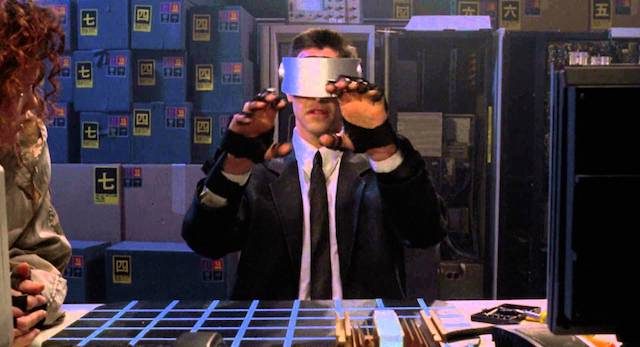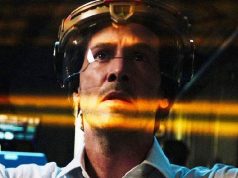
“Johnny Mnemonic” presents a grim vision of the future. It is set in 2021, a time of unimaginable horrors in which corporations run America and people die in the streets while pharmaceutical companies make obscene profits. In other ways, though, it is very different from the present. For example, in the future, all of humanity depends on information that only one person has, and that person is Keanu Reeves. A sobering prophecy indeed!
It is fair, if perhaps a bit impolite, to ask how important something can be, really, if only Keanu Reeves knows it. The actor’s usual persona is that of someone who is constantly being surprised and confounded by everyday things: words, buildings, the sky, other people, etc. How could he possibly be convincing as a character who knows something that no one else knows?
It may help if you realize that the reason he has this information is not that he has learned it, but that it has been digitally implanted into his brain. You see, in “Johnny Mnemonic,” Keanu plays a man who’s had an 80GB hard drive installed in his skull. Not just for fun (although that would be a good reason); Johnny makes a living as a courier, uploading secret or dangerous information to his head-drive and delivering it to whoever’s supposed to have it. You can’t just send stuff like that over the Internet in the future because of the “LoTeks,” which are homeless people who are also computer hackers who like to sabotage things. Homeless people who are also computer hackers who like to sabotage things are a regular fixture in the “cyberpunk” genre. The LoTeks think society has been ruined by an over-reliance on technology (and, apparently, soap), so they rebel by, uh, using technology to mess with other people’s technology. Look, maybe it all makes sense to them. I haven’t read their manifesto. Their leader is named J-Bone and he’s played by Ice-T, so I should think their bona fides are beyond question.
Anyway, Johnny doesn’t want to be a courier anymore. Installing the hard drive meant removing some of his personal memories — including the acting lessons! Hey-o! — and he’d like them back now, please. So he will do One Last Job, quit the business, get his memories back (I guess they’re in a jar or something), and return to whatever his profession was before he started whoring out his brain.
His final job seems standard enough. He has to upload the data from some suit-wearing men in Beijing and take it to some other besuited men in Newark, N.J. Warned ahead of time that this file transfer is especially bulky, Johnny doubles his 80 gigs to 160 gigs with a device called a doubler, because I guess that’s a thing. But hey, you know what? The data is even larger than expected. It is THREE HUNDRED AND TWENTY GIGABYTES! That is double the doubled amount of storage capacity in Johnny’s brain! Today, of course, we have devices with 320GB of memory that we only use for playing Words With Friends, but it was a lot in 1995. The film assumed that it would still be a lot in 2021. The film also has people using pay phones and fax machines in 2021, and no cell phones. Basically, apart from the details central to the story — the brain implants, the techno-sabotage, and so forth — the film predicted that 2021 would be just like 1995. You have to admire a prediction that’s both bold AND lazy.
Now, it might seem like an insurmountable obstacle to have a 320GB file and only 160GB of storage space. You would expect that when Johnny plugs the computer into the port in his head, he would get an error message that says, “There is not enough memory to complete the operation.” But that is not what happens! What happens is that he transfers the whole file anyway. The “capacity” is evidently more a suggestion than a hard-and-fast rule.
To exceed the capacity is not without dangers, however. You know how drug mules swallow balloons full of heroin to smuggle it into the country, but there’s always the risk that one of the balloons will disintegrate before the mule can poop it out? That is what’s happening with Johnny. He’s experiencing “synaptic seepage” that will kill him in a couple days if he doesn’t download the data to its destination first. In other words, Keanu Reeves is playing a character whose problem is that he has too much intelligence. Now the movie is just messing with us.
Johnny’s other problem is that there are some bad guys who want the information in his brain, and they are willing — eager, even — to cut off his head to get it. He has several scrapes with these gentlemen, giving him the opportunity to deploy some Action Hero One-Liners! These are often the high point of an action movie. Let’s check in on Johnny now:
[SCENE: Johnny is hiding in a bathroom while the bad guys kill the Beijing businessmen. Then one of the assassins, who by chance does not have any hair, bursts in, and Johnny knocks him out.]
JOHNNY: Next time knock, Baldy.
[End scene.]
Ha ha, good one?
Johnny hooks up with a junkie named Jane (Dina Meyer) who’s good at fighting, and offers her money to help him get the data out of his head. She knows a dude named Spider (Henry Rollins) who used to be a legitimate doctor and now does back-alley brain implants, and maybe he can retrieve the data. He can’t, as it turns out, but he does determine what the data is: it’s the cure for a disease called Nerve Attenuation Syndrome, or NAS, which has been killing everybody lately and which also had a long-running feud with Jay-Z. This is a big deal! Spider tells Johnny, “You’re not walking out of here! Not with that cure in your head!”
Meanwhile, beloved Japanese actor Takeshi Kitano plays the head of a pharmaceutical company who makes more money treating NAS than he would if it were cured, so he hires a deranged street preacher to assassinate Johnny. (It is standard practice in the pharmaceutical industry to contract the services of a religious-zealot-turned-hitman.) The street preacher is played by Dolph Lundgren, which makes perfect sense. “Johnny Mnemonic” is the sort of movie where when it’s over you say, “It seems like Dolph Lundgren should have been in that,” and then you remember that he was. It’s also the sort of movie where you figure at some point Johnny and Jane will need J-Bone’s assistance, so they’ll go the junkyard where the LoTeks all live, Fat Albert-style, and they’ll meet Jones, who is the LoTeks’ wisest and most powerful cyber-warrior, and Jones will turn out to be a partially mechanized dolphin. Yep, it’s one of those movies: movies where the resistance leader is a sea mammal connected to some wires.
Why a dolphin? Why a deranged street preacher? Why a junkie? Why Takeshi Kitano, Dolph Lundgren, and Ice-T? Why is the deceased founder of the pharmaceutical company still somehow living in the computer and harassing the new CEO like a ghost? Why everything? The movie’s a big, sloppy mess that feels like it was put together by one of those weird American kids who are obsessed with Japanese culture and watch anime all the time but don’t really understand it. At least it has a happy ending, though. In the end Johnny succeeds at downloading those 320 gigs and returning his brain to its natural state, unencumbered by knowledge or information. This is something we all strive for in the future.
— Film.com





